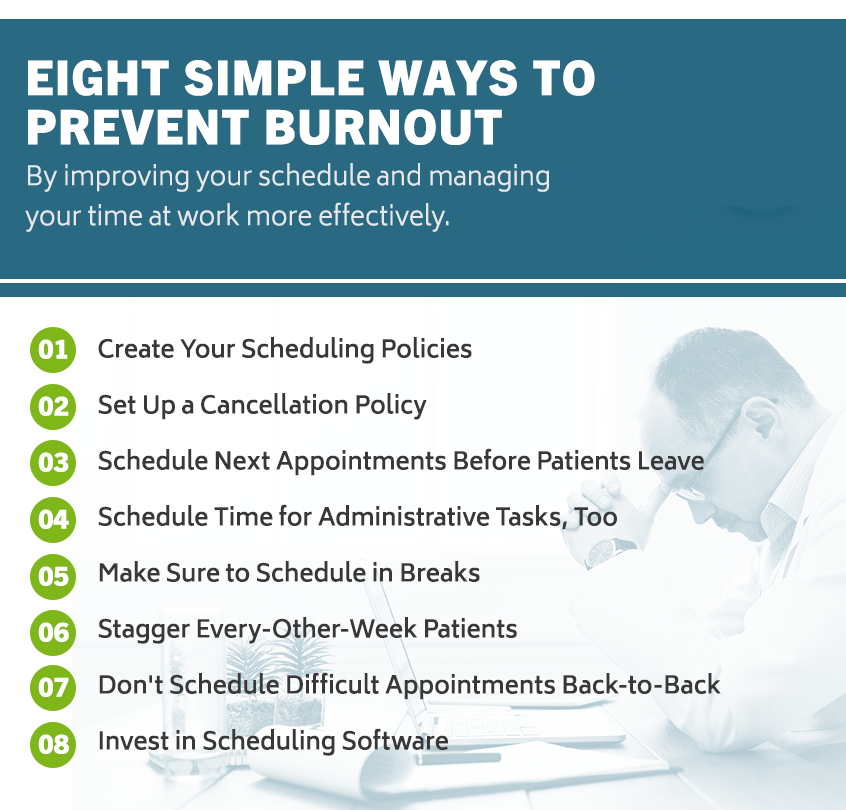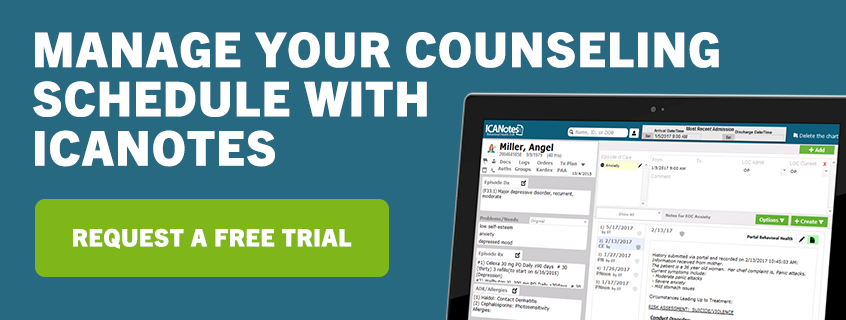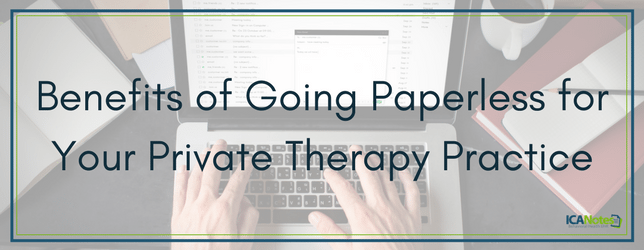8 Tips for Improving Your Counseling Schedule

As a mental health professional, you likely have a lot on your plate. Between patient appointments, administrative work and collaborating with colleagues, managing your schedule can be a challenge. Without an effective schedule, you may feel overwhelmed and overworked. Improving your counseling schedule and knowing how to manage your time effectively can give you the refresh you've been looking for.
Burnout makes the job you love feel like a chore. Consider these tips for improving your counseling schedule to manage your time more effectively and avoid burnout as a therapist.

How Poor Time Management Can Lead to Burnout
Burnout is so common for therapists to experience that it's estimated up to 60% of mental health professionals experience it. It starts with your best intentions as you try to accommodate and care for more clients. Before you know it, you have a full client load and are beginning to feel overwhelmed. Exposing yourself to other people's emotions and helping them process them can be overwhelming for you, too. While a full caseload may sound like a good thing, if you struggle to manage your counseling schedule effectively, you'll quickly overwork yourself.
Poor time management is one of the quickest ways to feel burnt out as a therapist. If you're experiencing signs of counselor burnout, such as decreased empathy, relief when patients cancel, daydreaming during sessions or dragging yourself to work, it may be time to consider how improving counseling schedules can help at your practice. Managing your time at work effectively helps you provide better patient care, leave work at the office and have time to refocus during the day.
Making big adjustments to your schedule may seem like more work than it's worth. However, there are several helpful techniques you can implement to help regain control of your counseling schedule. Creating policies and schedules that help you work more efficiently will refresh your love for your job and improve your professional relationships with your clients. Here are eight simple ways to prevent burnout by improving your schedule and managing your time at work more effectively.
Eight Simple Ways to Prevent Burnout

1. Create Your Scheduling Policies
If you don't already have scheduling policies in place, creating them is the best place to start making improvements to your schedule. Writing policies for your practice clearly outlines how you handle scheduling. Creating a formal policy allows you to share it with everyone on your team and with your clients. Doing so ensures everyone is on the same page and has the same expectations for your scheduling methods. Written policies also help hold your practice to a certain standard so each client receives the same level of care.
Your scheduling policies may outline any number of things, though this is an effective place to outline your appointment scheduling procedures. Write out what your clients should expect from you and what you expect from them. For example, make it clear whether your practice will contact the client to remind them of upcoming appointments and how they'll be contacted. Share how far in advance appointments can be scheduled and how far out you're taking appointments for. This method can help you and your clients stay organized.
When clients know your policies and have easy access to them, you'll run into fewer misunderstandings. Make your policies readily available on your website and post them in your office. When you meet with clients for the first time, review the scheduling policies with them in person and have the client sign to acknowledge that you discussed the policies with them. Notifying new clients of your policies at the beginning of your partnership helps minimize confusion and keeps your schedule organized.
2. Set Up a Cancellation Policy
There's nothing quite as frustrating as when clients cancel their appointments last minute or don't show up at all. When clients miss their appointments, they often fail to realize they're hurting you and your practice. If a client calls to cancel their appointment 20 minutes before, you have no time to fill that time slot — not only are you losing money, but another client is missing out on an opportunity to meet with you. In your cancellation policy, outline how their attendance affects your practice and other patients.
Include a plan in your policies for how you'll handle specific cases of cancellations and no-shows. Spelling these procedures out can help reduce their frequency. Your cancellation and no-show policy should be posted everywhere — on your website, in your office, at the reception desk and on appointment cards. As with your other policies, be sure to discuss this with your clients from the very beginning and have them sign off on it.
If cancellations and no-shows are a prevalent issue for your practice, you may consider charging a fee. For example, you may set specific fees in your policy for cancelations made within 48 hours and no-shows. This helps hold your clients accountable for their appointments, while still giving them a chance to cancel if necessary and providing you with at least some compensation for your time.
Another way to help prevent unnecessary cancelations is to require a prepayment when your client schedules an appointment. With this policy, clients will feel motivated to come for their appointment to avoid losing money.
3. Schedule Next Appointments Before Patients Leave
Asking your clients to schedule their next appointment before they leave is another effective way to improve your schedule. Relying on the patient to call back to schedule an appointment after they've gone home is risky because they'll likely forget. For a small to medium-sized practice, a lack of consistency can make it challenging to be profitable. Scheduling the next appointment while the client is still in your office eliminates the need for them to remember to call and schedule.
This technique also helps you plan out your schedule more effectively. When your patients schedule their appointments before leaving, you know you'll have appointment slots filled. If you leave it up to the client to go home and schedule their appointments, they might wait until the last minute, when it's too late to fit them in when they want. Scheduling in-person can also hold them accountable for showing up to their next appointment.
4. Schedule Time for Administrative Tasks, Too
Managing your time and improving your work schedule is about more than scheduling patient appointments. With so many roles and responsibilities, it can be easy for therapists to forget to make time for administrative tasks. When creating your availability, it's best to block off time specifically for taking care of these tasks. If you don't schedule time for other tasks into your day, you'll likely find yourself taking work home to tie up the loose ends you couldn't find time for in the office. Doing this every week can quickly lead to burnout.
Leaving yourself some time at the beginning or end of each day can help you wrap up client notes, respond to emails and plan for the next day. Adding time for administrative tasks into your schedule ensures you have time to complete them and helps eliminate the need to take work home with you. Taking time to work on something else also brings some variety to your day instead of sitting in client appointments from the start of your day until the end.
5. Make Sure to Schedule in Breaks
As a mental health professional, sometimes you forget to practice what you preach. Remember to take breaks throughout the day. Similar to scheduling time for administrative tasks, schedule yourself break times. Booking every day solid makes it feel like your practice is doing well, although you'll quickly feel run-down. Working through lunch a few times a week may seem like no big deal until it catches up to you. It's important to remember to take care of yourself so you can care for other people.
Scheduling breaks can be as simple as making sure each appointment on your schedule is at least 10 minutes apart. A little time between appointments gives you a chance to refresh your mind, decompress from a difficult discussion, answer an email or two, grab a snack and prepare for the next counseling session. Having a few minutes to yourself can be extremely beneficial, especially amidst a busy schedule. You'll be able to look at each session with fresh eyes and provide better care for your clients.
6. Stagger Every-Other-Week Patients
Weekly patients are easy to schedule, as they typically prefer to come at the same time and on the same day. Other patients may need to have appointments every other week. This may be the case because it's what they prefer or it's all they can afford. Regardless, how should you fit them into your weekly schedule? Stagger your every-other-week patients to spread out your appointments evenly and to ensure every other week isn't booked more heavily than the other weeks.
For example, if you have two patients who you meet with every other week, schedule them in the same time slot in alternating weeks. You'll see one biweekly patient one week and the other the next week. While some weeks will inevitably be busier than others, stagger biweekly patients to avoid having regularly scheduled busy weeks.
7. Don't Schedule Difficult Appointments Back-to-Back
Some appointments can be more difficult than others. Whether that means the patient requires more attention or has a complex situation that that poses certain challenges, these appointments tend to take more energy out of you. Planning for this can help to improve your counseling schedule and your care for all your clients. While it may sound like a good idea to schedule difficult appointments on the same day or back to back to get them out of the way, this can be exhausting and overwhelming.
When you're in control of your schedule, you can tailor it to spread these complex patients throughout your week. Be sure to give yourself time to process the information and emotions presented during a difficult appointment before attempting to address another complex case. This time span will differ for each therapist. Whether you need an hour or a day between challenging appointments, arrange them in your schedule to meet your needs and ensure you're able to provide the best care.
8. Invest in Scheduling Software
If you manage your schedule on paper, you've likely run into scheduling errors. Whether it was a missed appointment or two clients accidentally got double booked, managing your schedule using a pad of sticky notes is far from effective or reliable. You can easily misplace or throw out paper files keeping track of appointments. These errors can make your practice look unprofessional and is frustrating for both you and your clients.
If you schedule your appointments using pen and paper or a simple online calendar, it's time to consider scheduling software. Investing in scheduling software could significantly improve your counseling schedule and how you manage your time as a counselor. There are many benefits to using scheduling software, including:
- Improved organization: Electronic schedules keep all your appointments organized in one place so you can conveniently find each patient's appointments and view upcoming sessions at a glance. With scheduling software, all your appointments can be displayed on one screen — no more flipping through page after page of paper schedules. Scheduling software also enables multiple people to view the schedule at once. For example, if your secretary is scheduling an appointment in the lobby, you can also have the schedule open at the same time in your office.
- Instant updates: With paper schedules, there have likely been moments when patients showed up for appointments only for you to be surprised to see them. This is usually a result of miscommunication or a misplaced note about an appointment time change. Scheduling software instantly updates your schedule when changes are made to an appointment. Upload your weekly availability so anyone scheduling appointments can easily view open time slots, and watch as your schedule instantly updates as appointments fill up.
- Patient portal: Scheduling software also makes it easy to view all of a patient's information and documents all in one place. Patient portals make accessing patient information and appointments simple for both you and the patient. Electronic scheduling software enables your clients to use their portal to schedule and view their appointments. This saves you, your team and the patient time and gives them the power to adjust their appointment times as their schedules change.
Scheduling software can significantly improve the way you handle your counseling schedule. It helps simplify the appointment-making process and makes your practice look professional and established.
Manage Your Counseling Schedule with ICANotes
If you're ready to start improving your schedule and reaping the benefits of time management for counselors, invest in ICANotes electronic health record software. With ICANotes, managing your counseling schedule is simple. Our color-coded calendar is customizable to meet the needs of your individual practice. View your schedule by day, week or month to stay on top of your appointments. ICANotes calendar is integrated with our other features like a patient portal, billing services and charting to simplify managing your schedule and each appointment.
To find out how ICANotes can improve your counseling schedule, request a free trial today.










